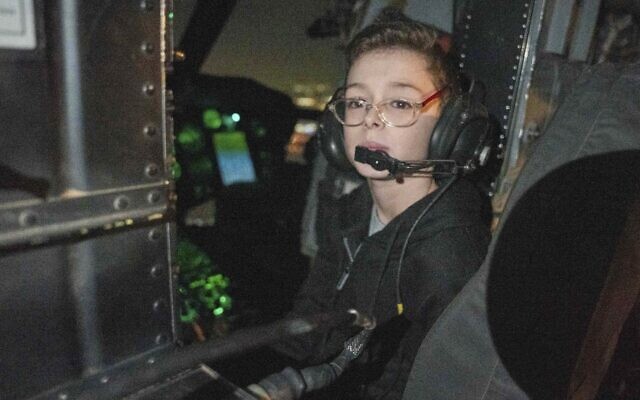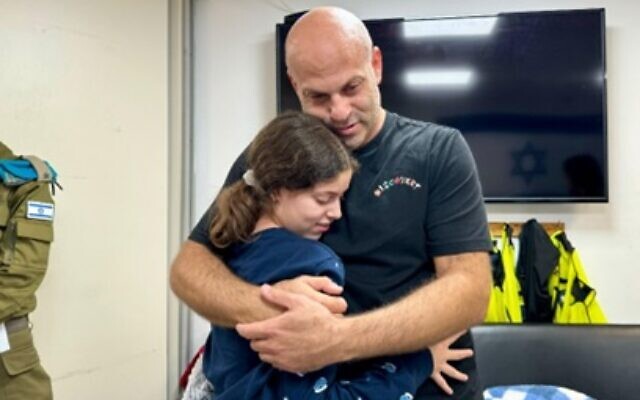Plastic chairs as beds. Meals of bread and rice. Hours spent waiting for the bathroom. As former hostages return to Israel after seven weeks of Hamas captivity, information about the conditions of their confinement has emerged.
The 58 hostages freed under a truce deal over the past three days have largely stayed out of the public eye, with most still in hospitals.
Nearly two months after Hamas terrorists dragged at least 240 people of all ages into Gaza during a bloody cross-border attack on Israel that also killed 1,200 people, most freed hostages appear to be in stable physical condition.
Information about the circumstances of their captivity has been tightly controlled, but family members of the released hostages have begun to share details about their loved ones’ experiences.
Merav Raviv, whose three relatives were released by Hamas on Friday, said they had been fed irregularly and had eaten mainly rice and bread. She said her cousin and aunt, Keren and Ruthie Munder, had each lost around 7 kilograms (15 pounds) in the seven weeks of their captivity.
Raviv said she’d heard from her freed family members that they had slept on rows of chairs pushed together in a room that looked like a reception area. They said they sometimes had to wait hours before being allowed to go to the bathroom.

Ruthie Munder, a released Israeli hostage, walks with an Israeli soldier shortly after her arrival in Israel, November 24, 2023. (IDF via AP)
Adva Adar, the grandchild of 85-year-old released hostage Yaffa Adar, said her grandmother had also lost weight.
“She counted the days of her captivity,” Adar said. “She came back and she said, ‘I know that I’ve been there for 50 days.'”

Keren Munder, left, with her first cousin, Merav Raviv, after being released from captivity in Gaza on November 24, 2023 (Courtesy)
Adar said that her grandmother was taken captive convinced that her family members were dead, only to emerge to the news that they had survived. Still, her release was bittersweet: She also found out that her house had been ravaged by terrorists.
“For an 85-year-old woman, usually you have your house where you raised your kids, you have your memories, your photo albums, your clothes,” said Adar. “She has nothing, and in her old age she needs to start over. She said that it is tough for her.”
On October 7, Hamas led over 3,000 terrorists to breach the border from the Gaza Strip and attack communities and areas in southern Israel, Most of the 1,200 people killed were civilians, including entire families murdered in their homes and 360 people slaughtered at a music festival. Victims, including children and babies, were raped, tortured, or mutilated.
In reaction to the attack Israel mobilized the IDF and began an air and ground assault aimed at destroying Hamas and removing it from power in Gaza, where it has ruled since 2007. The Hamas-run Gaza health ministry has said that more than 14,500 Palestinians, including 6,000 children, have been killed since October 7. These numbers cannot be independently verified and are believed to include members of the terror group, as well as civilians killed by misfired rockets, of which hundreds have fallen inside the Strip.
Under the current four-day truce, Hamas has agreed to release a total of 50 Israeli hostages in exchange for Israel releasing 150 Palestinian security prisoners and ramping up aid to the pummeled enclave.
Eighteen foreign nationals, mostly Thais, have also been released in a separate deal struck by their governments.
Eleven more hostages were set to be released Monday on the last day of the truce, leaving close to 180 hostages in the Gaza Strip. Israeli authorities have said that they are willing to extend the truce one day for every 10 additional hostages released by Hamas.
The fullest image yet of life under Hamas captivity was revealed by 85-year-old Yocheved Lifshitz, a hostage who was freed before the current truce. Upon her release, Lifshitz said she had been held in tunnels that stretched under Gaza “like a spider web.” She said her captors “told us they are people who believe in the Quran and wouldn’t hurt us.”
Lifshitz said captives were treated well and received medical care, including medication. The guards kept conditions clean and hostages were given one meal a day of cheese, cucumber and pita, she said, adding that her captors ate the same.

Freed Israeli hostage Yocheved Lifshitz speaks to the press, with her daughter at her side, at Ichilov hospital in Tel Aviv on October 24, 2023. (Avshalom Sassoni/Flash90)
The recently freed hostages also appeared to have been held underground. Eyal Nouri, the nephew of Adina Moshe, 72, who was freed on Friday, said his aunt “had to adjust to the sunlight” because she had been in darkness for weeks.
“She was in complete darkness,” said Nouri. “She was walking with her eyes down because she was in a tunnel. She was not used to the daylight. And during her captivity, she was disconnected… from the entire outside world.”
Nouri said that Moshe didn’t know that she was going to be released until the last moment.
“Until she saw the Red Cross,” he said. “This is the moment when she realized, okay, these horrifying seven weeks are over.”
She emerged to the news that her son’s family had miraculously survived. Her husband Sa’id David Moshe was murdered by terrorists in front of her eyes during the Hamas attack as he tried to defend the couple.

Released Israeli hostage Ohad Munder (9) sits inside an Israeli military helicopter, shortly after arrival in Israel on Friday, Nov. 24, 2023. A four-day cease-fire in the Israel-Hamas war began in Gaza on Friday with an exchange of hostages and prisoners. (IDF via AP)
Doctors have warned of the steep psychological toll of captivity. Israel has made counseling and other support available to those who have been released.
Still, most of the freed hostages have appeared to be in good physical condition, able to walk and speak normally.
But at least two needed more serious medical care. One hostage released Sunday, 84-year-old Elma Abraham, was rushed to Soroka Medical Center in the southern city of Beersheba in life-threatening condition. The hospital’s director said she had a preexisting condition that had not been treated properly in captivity.
Another young female hostage was on crutches in a video Hamas released Saturday. The girl grimaced at her captors as she entered a Red Cross vehicle bringing her out of Gaza.
#Israeli woman of 21 freed from captivity, seen on crutches,will need surgery, reports say. #Hamas has not released her brother of 18. Both siblings were taken hostage at a rave festival in southern Israel on the day of the Oct.7 massacres https://t.co/Tq1sr0QnWc
— Allyn Fisher-Ilan (@AFilan) November 26, 2023
Yair Rotem, whose 12-year-old niece, Hila Rotem Shoshani, was released Sunday, said he had to keep reminding her she didn’t need to whisper.
“They always told them to whisper and stay quiet, so I keep telling her now she can raise her voice,” said Rotem. He added that Hila, who will celebrate her 13th birthday on Monday, slept well during her first night back in Israel and has an appetite.

Hila Rotem Shoshani, 13, is embraced by her uncle as they reunite, in the early hours of November 26, 2023. (Israel Defense Forces)
Ohad Munder-Zichri, Raviv’s nephew, was surrounded by friends soon after his release, as they celebrated his 9th birthday a month late with ice cream and pizza in a hospital ward.
Ohad’s friend Eitan Vilchik told Israel’s Channel 13 that his friend was “emotionally strong” and already able to answer their questions about what he ate and what happened to him while he was in captivity. But Ohad’s friends refused to share details, saying they wanted to respect his privacy.
Vilchik said teachers have canceled Munder’s homework requirements but his friends will help him make up the material he missed in school.
He said Ohad was still able to solve a Rubik’s cube in less than a minute.
"some" - Google News
November 24, 2023 at 03:00PM
https://ift.tt/puhvVnl
Irregular meals, benches as beds: Details of captivity emerge as some hostages freed - The Times of Israel
"some" - Google News
https://ift.tt/Ip3UjtP
Shoes Man Tutorial
Pos News Update
Meme Update
Korean Entertainment News
Japan News Update
Bagikan Berita Ini














0 Response to "Irregular meals, benches as beds: Details of captivity emerge as some hostages freed - The Times of Israel"
Post a Comment